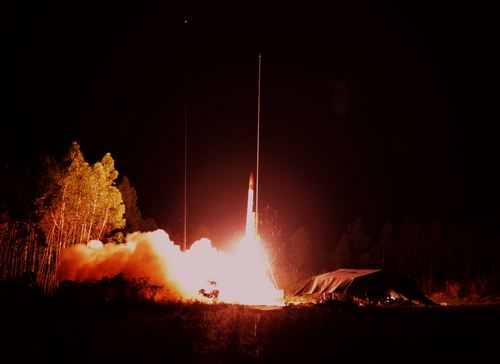NSSC Reseachers Complete the Space Environment Vertical Exploration
At 5:55 on April 5th, 2013, China's first space science active experiment was conducted in Hainan Sounding Rocket Launching Site of Chinese Academy of Sciences (CAS) on the outskirts of Danzhou City, Hainan Province.
The experiment named Space Environment Vertical Exploration will provide in-situ measurements for investigating the distributions of the key parameters of geo-space environment in low latitudes and calibration for ground-based remote-sensing observational facility.
The sounding rocket will release barium metal powder near the altitude of 200 km, forming a barium cloud. "By observing the development of the barium cloud, we can study the dynamical processes in the ionosphere near equator. This kind of active space science experiment has never been carried out in China," said WU Ji, chief commander of the experiment and director general of National Space Science Center of CAS.
"This is a new sounding rocket experiment conducted at Hainan Sounding Rocket Launching Site this year after the Meridian Project, a large scientific research project that monitors space weather," WU said.
The flight altitude of the rocket is 191 km and it takes about 8 minutes for the rocket to lift off and touch down. The rocket carries three science payloads, a Langmuir probe to determine the vertical distribution of the electrons and ions, an electric field probe to detect the vertical distribution of the space electric field. More than that, a barium-metal-powder releaser is deployed to study the dynamical processes in the ionosphere.
The carrier rocket TY-3E was developed by Academy of Aerospace Solid Propulsion Technology affiliated to China Aerospace Science and Technology Corporation.
The KUNPENG-1 sonde was jointly developed by National Space Science Center of CAS, Xi’an Institute of Optics and Precision Mechanics of CAS, and University of Graz in Austria.
National Space Science Center of CAS is also responsible for the overall management of the experiment, the rocket launching site, telemetry, the ground and scientific application system.
The Hainan Sounding Rocket Launching Site was set up in 1986. It has the capability of launching sounding rockets, and deploys more than ten ground-based space environment observational instruments. Its geographic location near equator makes the space environment observations unique and important in the world.

Launch scene of the TY-3E Carrier Rocket (Image by MU Chunlei)


